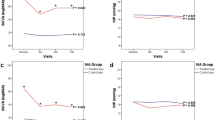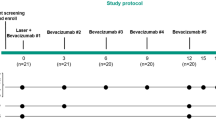Abstract
Purpose
The conventional dose of anti-vascular endothelial growth factor treatment may slowly reduce the subretinal fluid and height of a vascularized pigment epithelial detachment (vPED), but rarely leads to its complete resolution. We report a dramatic outcome involving a high dose (2 mg) of ranibizumab for treating vPED.
Methods
This report describes three eyes with vPED that received 2 mg in 0.05 ml of ranibizumab injections on a monthly basis and were followed prospectively. Each patient received a complete ocular examination, including best-corrected standardized ETDRS testing, fundus photography (FP), fluorescein angiography (FA), optical coherent tomography (OCT), and indocyanine-green angiography at baseline. ETDRS and OCT testing were repeated monthly, while FP and FA were performed every 3 months.
Results
Following a single intravitreal injection of 2 mg ranibizumab, there was rapid resolution of the subretinal fluid, haemorrhage, exudates, and flattening of the vPED within 10 days for Case 1, and within 1 month for Case 2 and Case 3.
Conclusion
Rapid and dramatic decrease in the exudative changes and collapse of the vPED may develop after a single injection of high-dose (2 mg) ranibizumab in certain eyes with a vPED. The improvement was maintained with additional monthly injections to 12 months.
Similar content being viewed by others

Introduction
Although multiple studies1, 2, 3, 4, 5, 6 and the pivotal ANCHOR and MARINA trials7, 8 have shown high efficacy in the treatment of choroidal neovascularization (CNV) due to age-related macular degeneration (ARMD) with anti-vascular endothelial growth factor (anti-VEGF) therapy, analysis of the responses based on specific lesion subtypes (ie, pigment epithelial detachments (PEDs)) was not performed. Previous studies have shown suboptimal and inconsistent outcome for the treatment of vascularized pigment epithelial detachment (vPED).7, 8, 9, 10 Although conventional doses of anti-VEGF therapy may reduce associated haemorrhage and intraretinal or subretinal fluid, the vPED does not typically resolve10 and residual visual disturbance may persist. Herein, we report three cases of rapid resolution of the vPED after only a single high dose (2 mg/0.05 ml) of ranibizumab. Approval by the respective institutional boards for this study and a full informed consent from all patients were obtained.
Case reports
Case 1
An 86-year-old man reported a 6-month history of metamorphopsia affecting the left eye (LE). Best-corrected VA was 20/30 in the right eye (RE) and 20/100 in the LE. Fundus examination showed nonexudative ARMD in the RE, and a large PED with a neovascular focus, consistent with vPED, in the LE, which was confirmed by fluorescein angiography (FA) and optical coherent tomography (OCT) imaging (Figures 1a–c). Baseline indocyanine-green (ICG) angiography showed no evidence of polypoidal choroidal vasculopathy (PCV) in the LE. Following a single injection of high-dose (2 mg) ranibizumab (Genentech Inc., San Francisco, CA, USA), resolution of subretinal fluid and collapse of the vPED were noted by day 10 post treatment visit (Figures 1d–f). Repeat high-dose injections were performed for the LE on a monthly basis. The vPED remained flat with improved vision (RE: 20/30, LE: 20/30) at the 12-month follow-up examination.
Case 2
A 60-year-old woman reported vision loss in both eyes for 3 months. The best-corrected VA was 20/30 in the RE and 20/100 in the LE. Macular atrophy was noted in the LE and subfoveal vPED in the RE, confirmed by FA and OCT (Figures 2a–c). Baseline ICG angiography showed absence of PCV in the RE. After a single injection of 2 mg ranibizumab, there was resolution of most of the subretinal fluid, hard exudates, and collapse of the vPED 1 month after the injection (Figures 2d–f). Injections were repeated for the RE on a monthly basis. Twelve months later, the vPED remained flat without leakage and associated with stable vision (RE: 20/20, LE: 20/100).
Case 3
An 85-year-old man presented with a 7-month history of progressive metamorphopsia affecting both eyes. Best-corrected VA was 20/60 in the RE and 20/400 in the LE. The posterior-segment examination showed a subfoveal vPED with hard exudates in the RE. There was an irregular vPED associated with diffuse subretinal fluid in the LE. FA showed CNV associated with a retinochoroidal anastomosis at the margin of the vPED in the RE (Figures 3a–c), and occult CNV associated with the vPED in the LE. Baseline ICG angiography did not show PCV in both eyes. He received 2 mg of ranibizumab, RE, initially, which was repeated on a monthly basis. His LE received 0.5 mg ranibizumab monthly. After a single injection, there was resolution of the subretinal fluid and exudates and flattening of the vPED in the RE 1 month after the injection (Figures 3d–f). After a follow-up of 12 months, there was no recurrent leakage, and the VA was 20/40 in the RE and 20/100 in the LE.
(a) Baseline FP and (b) FA of the RE showed a retinochoroidal anastomosis within a vPED. (c) Baseline OCT also confirmed the diagnosis of PED in the RE. His RE received 2 mg ranibizumab, and the LE also received conventional 0.5 mg ranibizumab injections. (d) After a single 2mg ranibizumab injection, there was resolution of the subretinal fluid and flattening of the vPED in the RE, as shown on follow-up FP, (e) FA, and (f) OCT 1 month later.
Discussion
The highly favourable outcomes on treatment of combined subtypes of neovascular AMD with conventional doses of ranibizumab shown by the pivotal clinical trials (ie, ANCHOR, MARINA, FOCUS, and SAILOR)5, 6, 11, 12 are not consistently achieved for vPED, a difficult-to-treat subtype of neovascular AMD. The aetiology of the slow and inconsistent response of vPED to conventional doses of anti-VEGF therapy is unknown.10 Rapid flattening of the PED with high-dose therapy may be explained by the greater concentration of ranibizumab that penetrates the RPE barrier and suppresses CNV and resolves the associated fluid and haemorrhage.
For our 3 cases, monthly maintenance injections were performed for 12 months. Patients were monitored on a prospective basis for ocular and systemic adverse events, and none of them developed any cardiovascular, neurological, or thromboembolic complications. However, further monitoring is needed to analyse potential ocular adverse events, such as RPE tears. The preliminary 1-year results of HARBOR, a large multicenter randomized trial, showed no dose–response safety signals relating to ocular or systemic adverse events (A Ho, unpublished data, AAO subspecialty day presentation, Orlando, October 2011).
In conclusion, this case series shows that high-dose ranibizumab may rapidly resolve vPED without complications. Further prospective analysis of a larger cohort of eyes is necessary to validate these outcomes.

References
Avery RL, Pieramici DJ, Rabena MD, Castellarin AA, Nasir MA, Giust MJ et al. Intravitreal bevacizumab (Avastin) for neovascular age-related macular degeneration. Ophthalmol 2006; 113: 363–372.
Fung AE, Lalwani GA, Rosenfeld PJ, Dubovy SR, Michels S, Feuer WJ et al. An optical coherence tomography-guided, variable dosing regimen with intravitreal ranibizumab (Lucentis) for neovascular age-related macular degeneration. Am J Ophthalmol 2007; 143: 566–583.
Chan CK, Meyer CH, Gross JG, Abraham P, Nuthi ASD, Kokame GT et al. Retinal pigment epithelial tears after intravitreal bevacizumab injection for neovascular age-related macular degeneration. Retina 2007; 27: 541–551.
CATT Research Group, Martin DF, Maguire MG, Ying GS, Grunwald JE, Fine SL, Jaffe GJ et al. Ranibizumab and bevacizumab for neovascular age-related macular degeneration. N Engl J Med 2011; 364: 1897–1908.
Brown DM, Kaiser PK, Michels M, Soubrane G, Heier JS, Kim RY et al, for the ANCHOR Study Group. Ranibizumab versus verteporfin for neovascular age-related macular degeneration. N Engl J Med 2006; 355: 1432–1440.
Rosenfeld PJ, Brown DM, Heier JS, Boyer DS, Kaiser PK, Chung CY et al, for the MARINA Study Group. Ranibizumab for neovascular age-related macular degeneration. N Engl J Med 2006; 355: 1419–1431.
Chuang EL, Bird AC . The pathogenesis of tears of the retinal pigment epithelium. Am J Ophthalmol 1988; 105: 285–290.
Pauleikoff D, Löffert D, Spital G, Radermacher M, Dohrmann J, Lommatzsch A et al. Pigment epithelial detachment in the elderly. Clinical differentiation, natural course and pathogenetic implications. Graefes Arch Clin Exp Ophthalmol 2002; 240: 533–538.
The Moorfields Macular Study Group. Retinal pigment epithelial detachments in the elderly: a controlled trial of argon laser photocoagulation. Br J Ophthalmol 1982; 66: 1–16.
Chen E, Kaiser RS, Vander JF . Intravitreal bevacizumab for refractory pigment epithelial detachment with occult choroidal neovascularization in age-related macular degeneration. Retina 2007; 27: 445–450.
Antoszyk AN, Tuomi L, Chung CY, Singh A, for the FOCUS Study Group. Ranibizumab combined with verteporfin photodynamic therapy in neovascular age-related macular degeneration (FOCUS): Year 2 results. Am J Ophthalmol 2008; 145: 862–874.
Boyer DS, Heier JS, Brown D, Francom SF, Ianchulev T, Rubio RG et al, for the SAILOR Study Group. A Phase IIIb Study to evaluate the safety of ranibizumab in subjects with neovascular age-related macular degeneration. Ophthalmol 2009; 116: 1731–1739.
Acknowledgements
This work was supported by Genentech Inc. (CKC, PA, DS), Owen Locke Foundation (CKC), and Karl Kirchgessner Foundation (DS). This study was approved by the Western Institutional Review Board and the UCLA Institutional Review Board, and conformed to the standards of the 1964 Declaration of Helsinki. All study subjects gave full informed consent.
Author information
Authors and Affiliations
Corresponding author
Ethics declarations
Competing interests
The authors declare no conflict of interest. This report constitutes the clinical application of a non-FDA-approved dosage of an FDA-approved medication.
Additional information
These cases were presented in part at the 43rd annual scientific meeting of The Retina Society, 23 September 2010, San Francisco, CA, USA.
Rights and permissions
About this article
Cite this article
Chan, C., Abraham, P. & Sarraf, D. High-dose ranibizumab therapy for vascularized pigment epithelial detachment. Eye 26, 882–885 (2012). https://doi.org/10.1038/eye.2012.90
Received:
Accepted:
Published:
Issue Date:
DOI: https://doi.org/10.1038/eye.2012.90
Keywords
This article is cited by
-
Earlier therapeutic effects associated with high dose (2.0 mg) Ranibizumab for treatment of vascularized pigment epithelial detachments in age-related macular degeneration
Eye (2015)
-
Current Strategies for the Management of Treatment-Resistant Neovascular Age-Related Macular Degeneration
Current Ophthalmology Reports (2014)
-
Alternative diagnosis for cases presented as vPED treated with high-dose ranibizumab
Eye (2012)
-
Response to Talks et al
Eye (2012)





